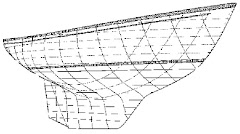There are two types of boaters, it's sometimes said: those who have run aground and those who will run aground. Monday, we became the former.
Our trip to the yard where we'll have Arione's teak decks replaced started off fine. We got off to a fairly early start from the little casita we're renting, get down to the boat, schlep the laundry and a last few things for the house up to the rental car, top off the water tanks and untie. There's no marked channel from Marina de La Paz south to the Singlar yard, but we have, we think, a pretty good handle on the route we need to take. The tide's going out, though, so we need to be careful. At first, everything's fine – 12, 15, 17 feet showing on the depth sounder, amazingly, actually matching what we're seeing on the chart. Then, things start getting skinny. We showing 8 feet, then 6, then 5 then... uh, oh. We're in the mud. Art backs off and tries another direction. Crap. In the mud again. The bottom's soft, so there's not a lot of worry about breaking the boat, but this is waaay too skinny for our tastes. We try yet another direction, and with a sickening sort of slurping feeling, we're hard aground. On a dropping tide. This is not good. If we have to wait to float off, we're going to be here until late afternoon, and still we'll have no idea what direction to go. We try gunning the engine in reverse. Nope. Heeling the boat over with the boom. Nope. Putting up the jib and seeing if the wind might take us off. Not a chance.
We call Reggie, who's doing the work on the decks. He says he'll try and get someone from the yard to come out and help, but they don't get in until 9:00, so it would likely be 10:00, with even less water, by the time they get to us. We hail the marina. At first, they say they can't get to us until 10:00 either, but Art points out the situation with the tide, and they say they'll get someone right out. A few minutes later, two pangas with guys in blue marina uniforms are headed our way. We get lines attached, and they start pulling. And pulling. And pulling. The boat heels over and I hear things crashing off the counters below, so I run down and put stuff away before it breaks. I am, at this point, starting to get a little freaked out. As Art pointed out, this wasn't exactly helping, but that's just where my brain seems to want to go. I have visions of us stuck here for days, waiting for the tides to come up. But what if this was a really high tide? What were the tides doing over the last few days? How could I not have checked. Hell, what were we even thinking, setting off into an uncharted bay on a falling tide. We are, clearly, idiots. Also, we have no idea what this is going to cost. What if it winds up being a salvage job? (a salvage job is a very expensive, complicated maritime law thing related to whether or not the boat's actually in danger.) Do these guys even know where the deep water is? My brain is doing me no favors here, going off on the worst possible tangents. After about 40 minutes, the pangas get us free. Those three guys just refused to give up (which is what I told the office at the marina when I stopped in today to leave a tip for them). We are both incredibly relieved.
We call Reggie again, and tell him we'll mill around in the marked channel until he can get a boat out to guide us in. He does one better than that, and gets a boat and an extra guy who has been in and out of Singlar a whole bunch of times on his own boat, which draws even more than we do. This guy comes aboard and sends us way up to the top of the bay to cross over to the channel which runs pretty much nowhere near where we thought it was along the Mogote (peninsula on the west side of Bahia de La Paz). It takes a long time, as we're sort of feeling our way along, dead slow, but we do eventually get to the head of the dredged, marked channel into Singlar. In addition to being incredibly reassuring, our helper (Bob? Bill? Why am I so bad at names?) Rob is good company. He left for San Diego later that afternoon, but we know which boat is his and are so buying him a drink (or several) when he gets back.
Of course, by the time we get to Singlar, the water is too low for them to get us out – the slings on the lift can't be lowered enough to get them under Arione. Reggie runs me back to Marina de La Paz so that I can take our rental car back to avoid being charged for an extra day. I get us checked out of the marina. Oh, and the towing bill? Just over $100 U.S. What a relief.






















